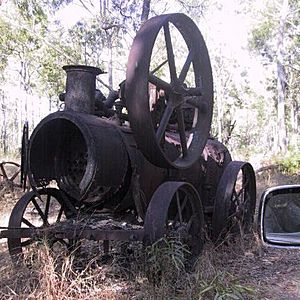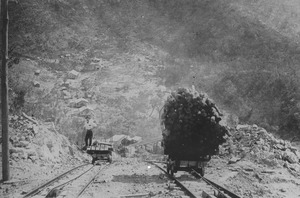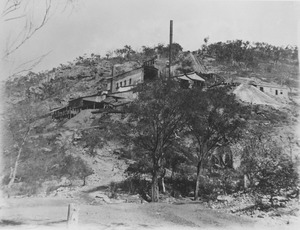Rocky Bluff Battery and Township facts for kids
The Rocky Bluff Battery and Township is an old mining town and processing plant located near Watsonville, in Queensland, Australia. It was built between 1902 and about 1926. This historic site is also known as the Stannary Hills Mill. It was officially added to the Queensland Heritage Register in 2002 because of its importance.
Quick facts for kids Rocky Bluff Battery and Township |
|
|---|---|

Remains of Rocky Bluff Battery
|
|
| Location | Watsonville, Shire of Mareeba, Queensland, Australia |
| Design period | 1900 - 1914 (early 20th century) |
| Built | 1902 - c. 1926 |
| Official name: Rocky Bluff Battery and Township, Stannary Hills Mill | |
| Type | state heritage (built, archaeological) |
| Designated | 13 December 2002 |
| Reference no. | 601861 |
| Significant period | 1902-c. 1926 (fabric) 1902-1911, 1912-c. 1926 (historical) |
| Significant components | chimney/chimney stack, furnace, embankment - tramway, weir, mounting block/stand, flue, wall/s - retaining, ropeway, tank - precipitation, terracing, fire box |
| Lua error in Module:Location_map at line 420: attempt to index field 'wikibase' (a nil value). | |
The Story of Rocky Bluff
Early Days and Tin Mining
Tin was first found in the Rocky Bluff area in 1883. Not much happened with it at first. Then, in 1900, a company from South Australia called the North Queensland Tin Mining Corporation bought many land leases.
This company later gave its properties to the Stannary Hills Mines and Tramway Company Limited. This new company, based in Adelaide, had a lot of money to invest. They decided to build a special narrow-gauge tramway. This tramway would run from Boonmoo to Stannary Hills and then to Watsonville.
Building the Tramway
The tramway line opened to Stannary Hills in May 1902. Instead of going straight to Watsonville, they decided to build a branch line. This new line was about 11 kilometers (7 miles) long. It went to Rocky Bluff, which was located on the Walsh River. This branch line opened on November 18, 1902.
The Battery is Built
The battery, which was a machine for crushing ore, was built in 1902. It was located on a 4-hectare (10-acre) area next to the Walsh River. Workers had to carry sand and gravel uphill from the river. Bricks were brought in on the Stannary Hills tramway. Then, they were lowered 190 meters (623 feet) down a hill to the battery site using a rope tramway.
The battery officially opened on May 6, 1903. It was named "Jumping Moses." This battery had 20 "heads" (large hammers for crushing ore), a Huntington mill, and a Merton furnace. All these machines were built high up on the steep hillside above the river.
Challenges and Improvements
The battery had to close in June 1903. The main problem was that the mortar box, where the ore was crushed, moved out of place. Also, there wasn't enough power from the boiler. The general manager, Charles S. Pasley, said the battery could only work at half power. A larger boiler was needed. They also planned to spend money on new equipment like "frue vanners" and "wheeler pans" to help process the ore better.
In 1905, big improvements were made. New foundations for the crushers and storage bins were built. Ten more crushing heads were added, and the old 20 heads were replaced. New rollers were put in to crush the ore even more. A special "grizzly" machine helped sort the crushed ore. A Krupp ball mill was added to grind the coarser parts of the ore. All the pumps were replaced with new ones. The brickwork of the Merton furnace was fixed. A "slime buddle" was also added to handle the very fine ore particles.
Water for the battery came from the river using wooden channels about 2 kilometers (1.2 miles) upstream. If the river flow was low, they pumped water from a dam. A powerful 350-horsepower engine ran the battery. A smaller 30-horsepower engine powered the ore-dressing plant. Steam for these engines came from Babcock and Wilcox boilers.
Life in the Township
By 1905, the small town of Rocky Bluff had about 200 people living there. It had a good hotel, a store, and a temporary school. The battery even supplied electricity to the school and some of the main buildings. The town also had running water from the same supply as the battery.
Because the town was built on a very steep hill, it was said that no wheeled vehicle, like a cart or buggy, ever made it into its main streets. A postal office operated from 1903 to 1907. In 1905, about 50 men worked at the battery and in general jobs at Rocky Bluff. Ore was brought in from nearby mines like the Arbouin, Ivanhoe, Extended, Kitchener, and Eclipse mines. The Arbouin mine was connected to the tramline by an aerial ropeway.
The Company's Decline
The Stannary Hills Company spent a lot of money, about £120,000, in three years. This money went towards tramways, equipment, buildings, and developing the mines. The company did very well when tin prices were high. However, after the tin market crashed in late 1907, the company's success ended. Between 1904 and 1911, when the company closed down, they produced tin worth £275,352.
In 1912, another South Australian company, John Darling and Company, bought the assets of the Stannary Hills Tramway and Tin Mines Limited. They made many repairs to reopen the battery. The battery was renovated again in 1917. It reopened with one work shift per day in late 1918. It continued to operate until the mid-1920s. The tramway line from the Junction to Rocky Bluff was taken apart in 1926.
What's Left Today
Today, you can still see parts of the Rocky Bluff site. These include:
- The path and end structures of the Stannary Hills - Rocky Bluff tramway.
- A ropeway path that went down from the tramway to the battery. It still has concrete mounts for the brakes.
- The foundations of the battery itself. These include terraced levels and tall retaining walls that go steeply down to the Walsh River.
- A stone weir (a small dam) built across the river.
- Two areas where the township once stood. One was on the flat ground near the river, and the other was in the gully below the battery.
The Battery Remains
The battery area has four main terraced levels. These levels are separated by tall rock walls.
- On the crusher level, you can see parts of brick walls and flues from a boiler house. There's also a large brick base for a metal chimney and concrete mounts for the engine.
- Nearby are three pairs of concrete foundations. These were for 30 crushing heads.
- The battery floor has three round brick bases that were for large mixing tanks. There's also a square brick chimney connected to brick tanks used for separating minerals.
- A lower furnace floor has the brick remains of a Merton furnace. Its flues connected to the chimney base. This area also has a small retort, which was an iron furnace with a brick firebox.
- Even lower, there are three round concrete-covered brick bases. These were for "buddles" used to treat the very fine ore particles.
Traces of the Township
There isn't much left of the settlement areas. You can find some timber stumps, rock walls, and a pile of green beer bottles. This pile might mark where a hotel or store used to be. A piece of a steel chimney has also been left on the settlement site. A small stone building still stands near where the town was.
Why Rocky Bluff is Important
A Look into Queensland's Past
The Rocky Bluff battery, tramway, and township are important because they show how mining developed in North Queensland a long time ago. It was an early example of different parts of a mining operation working together.
Unique and Rare Features
This place is special because it combines many functions in one spot. It had a steam tramway and its end point, a rope tramway going up a slope, a battery for crushing ore, a weir, and a settlement. This combination is quite unique. The battery, with its 30 crushing heads, was one of the biggest in the Mareeba district. The brick chimney and Merton furnace, even though partly broken, are a rare find together. It's one of the few battery sites in Queensland that still has a brick chimney.
Showing How Things Worked
Because it's hard to get to, the site has kept many clues about how things were laid out. You can still see how ore was transported, processed, and how the settlement was organized in the late 1800s. The battery's layout clearly shows the steps used to process the ore through the remaining structures and things found on the surface.
Beautiful and Historic Scenery
The battery site was chosen because it was efficient, being above the Walsh River. The mountains and river create a very impressive setting. This place also has important historical landscape values.



